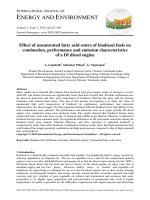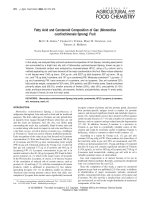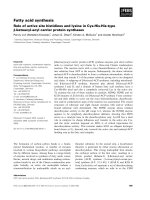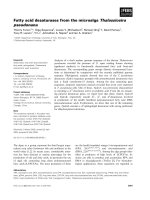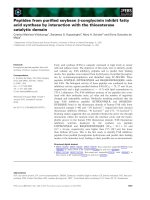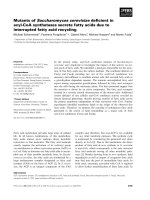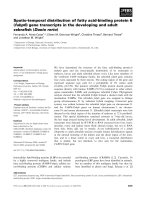Lecture Connections 17 | Fatty Acid Catabolism
Bạn đang xem bản rút gọn của tài liệu. Xem và tải ngay bản đầy đủ của tài liệu tại đây (3.33 MB, 69 trang )
Lecture Connections
17 | Fatty Acid Catabolism
© 2009 W. H. Freeman and Company
CHAPTER 17
Fatty Acid Catabolism
Key topics:
– How fats are digested in animals
– How fats are mobilized and transported in tissues
– How fats are oxidized
– How “ketone bodies” are produced
Oxidation of Fatty Acids is a Major
Energy-Yielding Pathway in Many
Organisms
• About one third of our energy needs comes from
dietary triacylglycerols
• About 80% of energy needs of mammalian heart
and liver are met by oxidation of fatty acids
• Many hibernating animals, such as grizzly bears
relay almost exclusively on fats as their source of
energy
Fats Provide Efficient
Fuel Storage
• The advantage of fats over polysaccharides:
– Fatty acid carry more energy per carbon because they
are more reduced
– Fatty acids carry less water along because they are
nonpolar
• Glucose and glycogen are for short-term energy needs,
quick delivery
• Fats are for long term (months) energy needs, good
storage, slow delivery
Dietary Fatty Are Absorbed in the
Vertebrate Small Intestine
Lipids are Transported in the
Blood as Chylomicrons
Hormones Trigger Mobilization of
Stored Triacylglycerols
Hydrolysis of Fats Yields Fatty Acids
and Glycerol
• hydrolysis of triacylglycerols is catalyzed by lipases
• some lipases are regulated by hormones glucagon
and epinephrine
• epinephrine means:
“we need energy now”
• glucagon means:
“we are out of glucose”
Glycerol from Fats Enters
Glycolysis
• Glycerol kinase activates glycerol at the expense of
ATP
• Subsequent reactions recover more than enough
ATP to cover this cost
• Allows limited anaerobic catabolism of fats
Fatty Acids are Converted into
Fatty Acyl-CoA
Fatty Acid Transport into
Mitochondria
• Fats are degraded into fatty acids and glycerol in
the cytoplasm
• -oxidation of fatty acids occurs in mitochondria
• Small (< 12 carbons) fatty acids diffuse freely
across mitochondrial membranes
• Larger fatty acids are transported via acylcarnitine / carnitine transporter
Acyl-carnitine / Carnitine Transport


